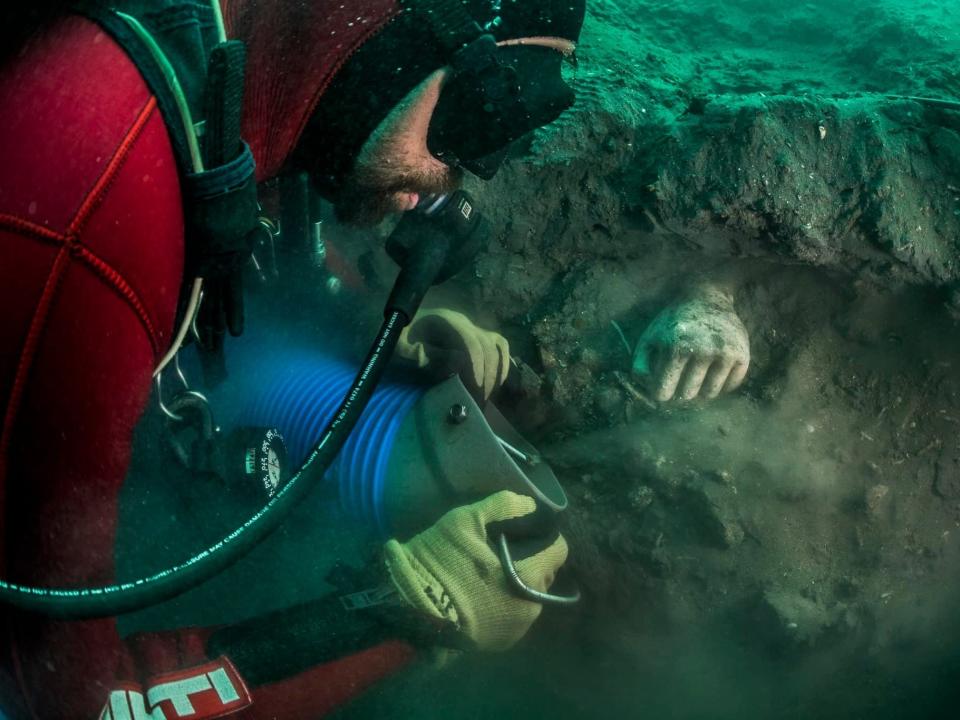Sunken ancient temples were found in a mysterious underwater city, with Egyptian and Greek treasures
Archaeologists uncovered a treasure trove of ancient Egyptian and Greek artifacts.
It included gold and silver trinkets, likely used in ritual ceremonies to bless the pharaohs.
They were found on the site of the sunken city of Thonis-Heracleion, which was lost until 2000.
A treasure trove of ancient Egyptian and Grecian artifacts has been uncovered in sunken temples in a mysterious underwater city off the coast of Egypt.
A team of archaeologists made the discovery while working to uncover the legendary site of Thonis-Heracleion, an Egyptian port city that completely disappeared after sinking into the Mediterranean more than 1,000 years ago.
The new excavation revealed the gold and silver treasure of the sunken temple of Amun, which included artifacts that were likely used to bless the pharaohs as they ascended to the throne. It also found a Grecian temple to Aphrodite and ancient Greek weapons.
"It is very moving to discover such delicate objects, which survived intact despite the violence and magnitude of the cataclysm," Franck Goddio, the president of the European Institute for Underwater Archaeology, who led the excavation with the Ministry of Tourism and Antiquities of Egypt, said in a statement seen by Insider.

The lost city of Thonis-Heracleion was only found about 20 years ago
Thonis-Heracleion had long been relegated to the status of legend until it was uncovered in 2000 by Goddio and his team.
Established near the mouth of the Nile, Thonis-Heracleion was once the biggest port city in the Mediterranean. Until Alexandria was established, it was a hugely important political site, an obligatory point of entry into Egypt for all ships coming from Greece, and a hub of ritual ceremonies for the ruling class, according to Goddio's website.
But rising water, a series of earthquakes, and a tidal wave contributed to liquefying the soil under the city. Thonis-Heracleion eventually slowly disappeared into the Mediterranean, in what is now known as Aboukir Bay in Egypt, until it had completely vanished by the eighth century.
The city's name and story were lost through the centuries, only being mentioned in passing in ancient classic texts and rare inscriptions, Goddio's website says.
Using detailed survey work, Goddio and his team eventually discovered its remains, buried in deep layers of sediment underwater. They've been working to uncover the secrets of the lost city for the past two decades.

A temple to the king of ancient Egyptian gods
The latest excavation located a precious site: the sunken temple of Amun.
The temple would've had a special significance for Egyptians at the time. Amun was the king of the Egyptian gods. Accordingly, this is where the pharaohs at the time would have gone to be blessed as they rose to power, the statement says.

At the site, the archaeologists discovered artifacts from the temple's treasury, including gold jewelry and a "Djed pillar," a symbol of stability, made of a blue semi-precious stone named lapis lazuli.
They also found silver platers and an alabaster container that were probably used to contain perfumes and unguents during ritual ceremonies. Silver would have been extremely rare in ancient Egypt and would have been seen as a very precious commodity, the statement said.

Some discoveries that were made did not contain precious metals but could hold just as much archaeological significance. Wooden structures wrapped in papyrus dating back from 500 BC were also found during the dig. These would have been part of the underbelly of the temple.
Goddio said in a translated statement seen by Insider that he was very moved to find these structures, as these would have been hidden from most people's view, even back when they were first built.
A Grecian sanctuary dedicated to Aphrodite was located nearby

The excavation also uncovered another sacred site, but this time, it was devoted to ancient Greek rituals.
East of the temple of Amun, Goddio and his team found the bronze and ceramic objects from a sanctuary dedicated to Aphrodite, the Grecian goddess of love and beauty.
This is proof that ancient Greeks, who were allowed to trade in the city, had started to take root in Thonis-Heracleion during the 26th dynasty of Egypt, about 2,500 years ago, the statement said.
Weapons at the site also suggest Grecian mercenaries were employed in Thonis-Heracleion, likely to defend the city, the statement added.
Read the original article on Business Insider

 Yahoo News
Yahoo News 
